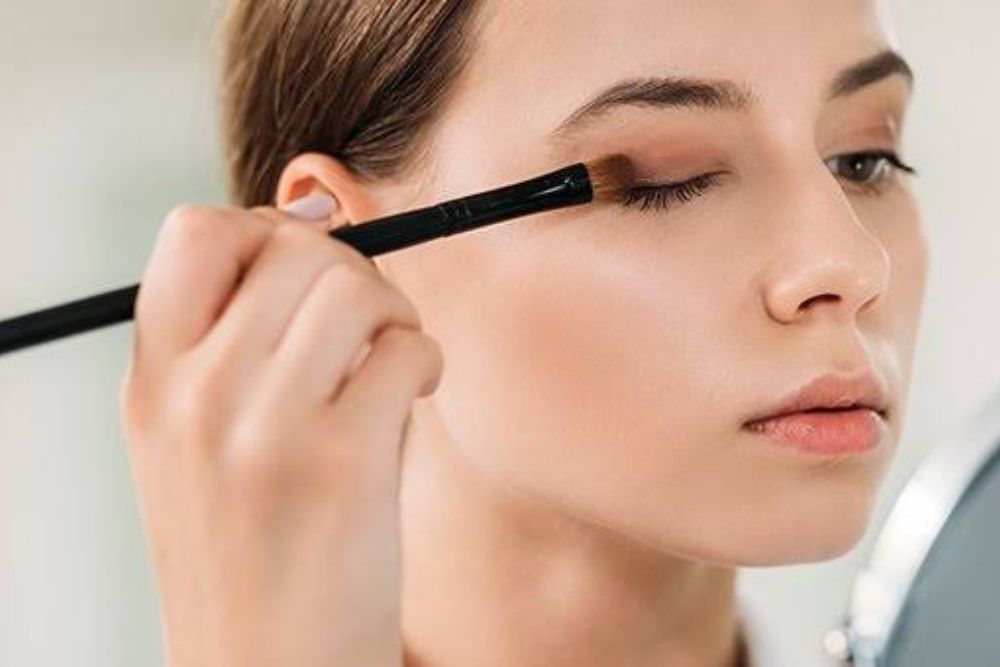
Inappropriate methods of applying products to the face, especially in the periocular area, have consequences for visual health. To prevent this, put into practice the recommendations that ensure safe makeup around the eyes.
Some modern touches that enhance the eyes are based on phosphorescent shadows, adhesive crystals, masks and lash extensions. Likewise, there are cosmetics that increase the risk of damage to skin as vulnerable as the skin around the eyes.
We will never stop emphasizing the importance of hygiene and care in beautifying the eye area so that the aesthetic is not spoiled. Remember that the skin around the eyelids and under the eyes is the thinnest on your body, so it deserves special attention.
Why Is It Important to Apply Safe Makeup Around the Eyes?
Reasearch points out that the average thickness of the dermis layer near the eyes is five times thinner than the rest of the face. In addition, it is easily distended by continuous blinking and contains less collagen.
Because of this sensitivity, it requires meticulous treatment, even with makeup. Excessive or inappropriate products can cause adverse effects that sometimes require medical intervention.
The skin around the eyes is extremely delicate. It is therefore advisable to be careful when applying makeup.
Main Reactions to Not Wearing Safe Makeup Around the Eyes
If you use the cosmetics correctly, there will be no consequences. On the other hand, when you don’t wear safe makeup around the eyes, you will expose yourself to reactions such as the following.
- Irritation: During the makeup process, certain particles can fall on the surface of the eyes and inflame them.
- Dry eyes: This effect is caused by harmful chemicals. Be careful with alcohols, preservatives, tar and waxes.
- Allergies: According to the American Academy of Ophthalmology (AAO), allergic reactions and conjunctivitis from cosmetics are often caused by preservatives. The item should be labeled as paraben-free.
- Lacrimal obstruction: This is the blockage of the normal flow of tears due to infection or inflammation. It manifests itself through tearing, redness of the sclera and blurred vision, among other symptoms. Contaminated mascara and eyeliner trigger this condition.
- Ocular dermatitis: Due to the composition of some daily-use cosmetics, the skin may become itchy, swollen or erythematic.
- Blepharitis: This condition inflames the edge of the eyelids and sometimes requires long-term treatment.
Recommendations for Safe Makeup Around the Eyes
Consult your dermatologist about your beauty routine, especially if you have an eye condition. It is advisable to use makeup created for the eye area.
For example, the Food and Drug Administration (FDA) points out that the same pencil used to line the lips and eyes would transmit germs from the mouth to the eye.
Also, throw out cosmetics that have been open for more than 3 months and add hypoallergenic products to your list, as well as those created by recognized laboratories. It is also advisable to keep the products in a cool place and always wash your hands before starting to use them.
Other recommendations for safe eye makeup include:
Using Clean Tools
Leaving applicators (such as brushes and sponges) filled with foundation, shadow, concealer or illuminator for an extended period of time encourages the growth of bacteria and fungi.
One way to sanitize utensils is to soak them in warm water, then immerse them in a mixture of water and pH-neutral shampoo or soap. Rub them in the palm of your hand and let them dry upside down.
Checking the Ingredients
Looking closely at what it says on the label is the only way to know if the makeup contains ingredients that aren’t good for you. If you have any doubts about the composition, ask the seller or look at the information that manufacturers post on their websites or social networks.
Don’t Lend Makeup
Sharing eye makeup is a mistake. Other people’s germs can get onto your skin this way.
Use New Applicators
Don’t use the fitting rooms in stores, as all customers do. It’s best to bring your own applicators or use cotton swabs. This advice is not limited to eye makeup.
Putting Makeup on a Static Spot
Try not to apply makeup in the car, even if you’re not driving. Sudden stops and pothole drops put you at risk of injury from your mascara wand or eyelash curler.
Be Careful with Additives
Eye makeup has particular colorings. Obtaining such pigments compromises the use of strictly regulated additives. Avoid unauthorized additives, as they denature the product and harm the skin.
The FDA summarizes in a list the color cosmetic additives accepted by the institution.
Be Careful with Eyelash Glue
Eyelash extensions are fashionable because of their power to accentuate the look. This touch is safest when the glue that adheres them to the eyelid is light, doesn’t leave clumps and cleans up easily. If the glue does not have dermatological approval, it increases the possibility of infection or inflammation.
The glue used for eyelashes must be dermatologically approved. Otherwise, there are risks.
What to Do in Case of an Adverse Reaction to a Cosmetic?
People with sensitive skin are not the only ones prone to imperfections from unsafe makeup around the eyes. Anyone can have a complication.
If you experience an adverse reaction to a cosmetic, seek medical attention, especially if symptoms persist for several days. While you are healing, do not apply makeup to the area.
There you are! With those tips, you should be able to apply makeup safely around your eyes. What’s your favorite eye makeup style? Let us know in the comments below.


